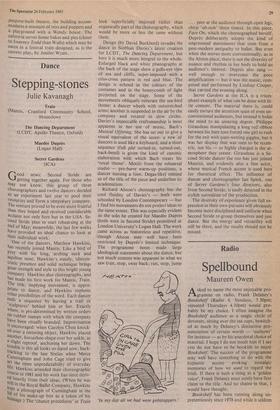Dance
Stepping-stones
Julie Kavanagh
Train (Mantis, Cranford Community School, Hounslow) The Dancing Department (LCDT, Apollo Theatre, Oxford) Secret Gardens (ICA)
Good news: Second Stride are getting together again. For those who may not know, this group of three choreographers and twelve dancers decided as an experiment last year to pool their resources and form a tempoi-ary company. The venture proved to be even more fruitful than they hoped and received considerable acclaim not only here but in the USA. Se- cond Stride plan to start rehearsing at the end of May; meanwhile, the last few weeks have provided an ideal chance to look at their individual work.
One of the dancers, Matthew Hawkins, has recently joined Mantis. Like a bird of Prey with his long, arching neck and aquiline nose, Hawkins's stately, idiosyn- cratic presence and solid technique brings great strength and style to this bright young Company. Hawkins also choreographs, and has made his first work for Mantis, Train. The title, implying movement, is appro- priate to dance, and Hawkins explores other possibilities of the word. Each dancer ends a sequence by leaving a trail of `sculptures' behind him or her. Exactly where, is pre-determined by written orders on rubber stamps with which the company have been ritually branded. Improvisation is encouraged: when Carolyn Choa knock- ed over a teetering object, Hawkins placed another, horseshoe-shape over her ankle, as a slight reproof, anchoring her down. The trouble is this all looks so dated now, back- tracking to the late Sixties when Merce Cunningham and John Cage tried to give art the open unpredictability of everyday life. Hawkins attended their choreographic course in 1981 and his work has since deriv- ed heavily from their ideas. (When he was still in the Royal Ballet Company, Hawkins kePt a photograph of Cunningham in the Lid of his make-up box as a token of his homage) The 'chance procedures' in Train
look superficially imposed rather than organically part of the choreography, which would be more or less the same without them.
Design (by David Buckland) invades the dance in Siobhan Davies's latest creation for LCDT, The Dancing Department, but here it is much more integral to the whole. Enlarged black and white photographs at the back of the stage show a gulls-eye view of sea and cliffs, super-imposed with a criss-cross pattern in red and blue. The design is echoed in the colours of the costumes and in the honeycomb of light projected on the stage. Some of the movements obliquely reiterate the sea-bird theme: a dancer wheels with outstretched arms; another is suspended in the air by the company and rotated in slow circles. Davies's impeccable craftsmanship is most apparent in her use of music, Bach's Musical Offering. She has set out to give a visual equivalent of the score: a row of dancers is used like a keyboard, and a short sequence (full plie turned-in, turned-out, back-bend) is given the kind of canonic elaboration with which Bach treats his `royal theme'. Motifs from the rehearsal studio — pre-barre warm-up positions, a dancer nursing a foot, Degas-like) remind us of the title of the piece and underline its academicism.
Richard Alston's choreography has the cool fluidity of Davies's — both were schooled by London Contemporary — but I find his movements do not project ideas to the same extent. This was especially evident in the solo he created for Maedee Dupres (both were in Second Stride) premiered at London University's Logan Hall. The work came across as featureless and repetitive, 'though Alston may well have been restricted by Dupres's limited technique. The programme notes made large ideological statements about the dance, but not much content was apparent in what we saw (run, stop, sway back; run, stop, jump
'In my day all we had were gobstoppers.'
.. peer at the audience through open legs, chirp `uh-ooh' three times). In this piece, Face On, which she choreographed herself, Duprts deliberately adopts the kind of ungroomed movements that stem from a post-modern antipathy to ballet. But even when she moves more conventionally, as in the Alston piece, there is not the diversity of nuance and rhythm in her body to hold an audience's interest. Dupres also sang well enough to overcome the poor amplification — but it was the music, com- posed and performed by Lindsay Cooper, that carried the evening along.
Secret Gardens at the ICA is a trium- phant example of what can be done with lit- tle content. The material there is, could easily torture the attention span of even un- conventional audiences, but instead it holds the mind to an amazing degree. Philippe Giraudeau manipulating a long red ribbon between his bare toes forced one girl to rush for the exit with pant-wetting giggles, but it was her display that was seen to be eccen- tric, not his — so highly charged is the at- mosphere they create. Giraudeau is a Se- cond Stride dancer (he too has just joined Mantis), and evidently also a fine actor, whose musical French accent is used here for rhetorical effect. The influence of dancer and choreographer Ian Spink, one of Secret Gardens's four directors, also from Second Stride, is easily detected in the stylish surrealism of the production.
The diversity of experience given full ex- pression in their own pursuits will obviously become more disciplined and uniform when Second Stride re-group themselves and just dance. But the energy and versatility will still be there, and the results should not be missed.










































 Previous page
Previous page